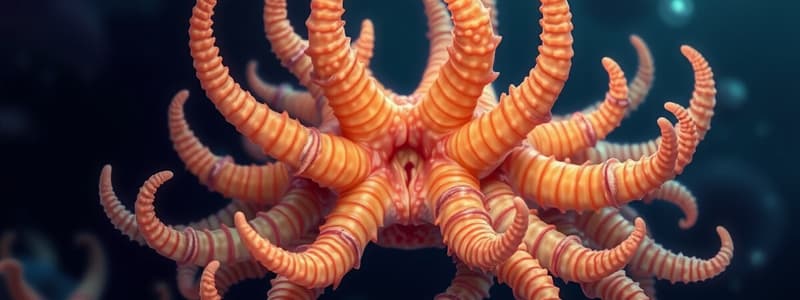Podcast
Questions and Answers
What phylum do Ophiuroidea belong to?
What phylum do Ophiuroidea belong to?
- Annelida
- Mollusca
- Echinodermata (correct)
- Arthropoda
Which of the following are synapomorphies of Ophiuroidea? (Select all that apply)
Which of the following are synapomorphies of Ophiuroidea? (Select all that apply)
- Star-shaped with 5 slender arms distinct from flat central disk (correct)
- Tube feet without ampullae or suckers (correct)
- Presence of an anus
- Madreporite on the oral surface (correct)
Name three organisms that are included in Ophiuroidea.
Name three organisms that are included in Ophiuroidea.
Brittle stars, basket stars, snake stars.
Ophiuroidea exhibit __________ locomotive behavior.
Ophiuroidea exhibit __________ locomotive behavior.
What is the feeding strategy of Ophiuroidea?
What is the feeding strategy of Ophiuroidea?
What is the function of mucous strings in Ophiuroidea?
What is the function of mucous strings in Ophiuroidea?
Ophiuroidea have a complete digestive system with an anus.
Ophiuroidea have a complete digestive system with an anus.
What is the advanced larval stage of ophiuroids called?
What is the advanced larval stage of ophiuroids called?
How do brittle stars capture food?
How do brittle stars capture food?
What are genitorespiratory bursae used for in Ophiuroidea?
What are genitorespiratory bursae used for in Ophiuroidea?
What type of reproduction is referred to as fissiparity?
What type of reproduction is referred to as fissiparity?
Flashcards are hidden until you start studying
Study Notes
Phylum Ophiuroidea Overview
- Ophiuroidea is a class within the phylum Echinodermata.
- Includes organisms such as brittle stars, basket stars, and snake stars.
Key Synapomorphies of Ophiuroidea
- Characterized by a star-shaped body with five distinct slender arms separate from a flat central disk.
- Oral arm plates cover the ambulacral groove, enhancing feeding mechanisms.
- Possess tube feet that lack ampullae and suckers, simplifying locomotion.
- Absence of an anus; the madreporite is located on the oral surface.
External Anatomy Features
- Arms are easily detachable as a defense mechanism.
- No external open ambulacral groove, pedicellariae, or papulae, distinguishing them from other echinoderms.
- Podia are arranged in pairs and are protected by tentacle scale ossicles.
- The aboral disk surface can be smooth, leathery, granular, spiny, or plated.
- Jaws are fitted with oral shields edged with tooth-like spines.
- Cilia mostly present on the oral surface of the disk and arms, as well as around bursal slits.
Internal Anatomy Characteristics
- Digestive system functions as a blind sac, lacking an anus or intestine.
- Water vascular system includes a ring canal, radial canals, and four Polian vesicles; radial canal is positioned beneath the vertebral ossicles of the arms.
- Perivisceral coelom is largely filled by the gut, gonads, and bursae.
- Hemal and nervous systems are similar to those found in asteroids.
Unique Species: Ophiocoma wendti
- Features light-sensitive epidermis with a glowing nerve network.
- Pigment-bearing cells shift position during the day, working as "sunglasses" to protect against excess light.
Locomotion Mechanism
- Movement achieved through arm crawling using a rowing motion, independent of the water vascular system.
- Podia serve dual purposes: digging into substrates and acting as adhesive structures.
Feeding Strategies
- Ophiuroidea species are primarily detritivores and carnivores, utilizing suspension feeding methods.
- Mucous strings are used to trap plankton and are transported to the mouth with the help of cilia.
Mucous Strings Functionality
- Mucous strings are effective in capturing plankton; these are coiled and directed to the mouth via ciliary action.
Feeding Adaptations in Basket and Snake Stars
- Develop hooked spines that effectively snare larger zooplankton for nourishment.
Reproductive Anatomy
- Genitorespiratory bursae are situated around the central disk, located between each arm; they contain gonads and facilitate gas exchange and reproduction.
Asexual Reproduction Method
- Fissiparity enables asexual reproduction through fission, allowing for new individuals to form from existing ones.
Advanced Larval Stage
- The Ophiopluteus larval form possesses four pairs of elongated flagellated arms supported by calcareous rods, representing a more developed stage of the organism's lifecycle.
Feeding Mechanism in Brittle Stars
- Brittles stars utilize podia on their arms to capture food, which are then passed to their mouth for consumption.
Studying That Suits You
Use AI to generate personalized quizzes and flashcards to suit your learning preferences.

